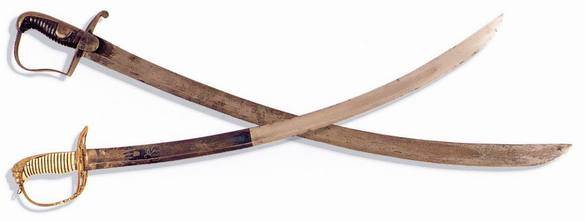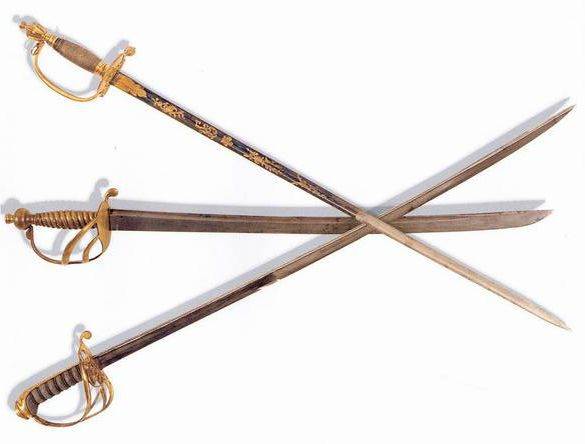The Canadian 19th Century Flank Companies
Welcome to a journey back in time to explore the rich heritage of the Canadian 19th Century “Flank Companies” - Grenadiers and Light Infantry. This article will delve into the history, accomplishments, and significance of these elite military companies in the Canadian Regiment. With a focus on the 19th century, we will discover the role they played in shaping Canadian military history and their contributions to the nation's defence. Also we will discuss the swords found within this respected Canadian regiment and throughout the 19th century. So, grab your virtual time machine as we embark on this exciting adventure!
Grenadiers and Light Infantry: A Brief Overview
The Canadian 19th Century Flank Companies - Grenadiers and Light Infantry were pivotal units within the Canadian military during the 19th century. These flank companies comprised of elite specialized soldiers served alongside regular infantry battalions. They were tasked with providing additional firepower and tactical support during engagements, reinforcing the main body of troops on the battlefield.
Canadian Grenadiers
The Canadian Grenadiers Companies had several specialized roles within the flank company. They were trained to excel in offensive operations, such as storming enemy fortifications, engaging in hand-to-hand combat, and leading decisive assaults. Their primary weapons were muskets or rifles, but they were also skilled in using grenades and bayonets. Their specialized training and equipment made them a formidable force on the battlefield.
To become part of the Canadian Grenadiers Companies, soldiers had to undergo rigorous training. The training focused on developing their physical strength, combat skills, and discipline. Grenadiers were required to possess exceptional marksmanship, hand-to-hand combat proficiency, and the ability to withstand and deliver punishing blows. They were also trained in formations and tactics specific to assault and close-quarters combat.
The Canadian Grenadiers Companies had distinctive uniforms and insignia that set them apart from other units. They often wore tall bearskin caps or helmets adorned with plumage, which added to their imposing presence on the battlefield. The uniform was usually more elaborate than that of regular infantry, with ornate trimmings and distinctive colors denoting their elite status.
The Canadian Grenadiers Companies were known for their bravery and valor in battle. They played crucial roles in major conflicts, including the War of 1812 and the Fenian Raids. Their acts of heroism and unwavering commitment to their duties earned them respect and recognition within the Canadian military and beyond. The Grenadiers' contributions to the success of various military campaigns were significant and left a lasting impact on Canadian military history.
Canadian Light Infantry
The concept of Light Infantry originated in the 18th century as a response to the changing nature of warfare. Light Infantry units were designed to operate independently, scouting enemy positions, conducting raids, and engaging in skirmishes. As warfare evolved, so did the role of Light Infantry, with their swift and agile tactics becoming increasingly important in the 19th century.
The Canadian Light Infantry excelled in a wide range of battlefield tasks. Their primary role was reconnaissance, gathering vital information about enemy positions, terrain, and troop movements. They utilized stealth and camouflage techniques to infiltrate enemy lines undetected. In addition, they were skilled in marksmanship and guerrilla-style warfare, capable of delivering accurate and deadly fire while on the move.
What set the Canadian Light Infantry apart was their exceptional mobility and adaptability. They were trained to traverse difficult terrain, such as forests, mountains, and marshlands, with ease. Their ability to move swiftly and silently allowed them to quickly respond to changing circumstances on the battlefield. The Light Infantry often operated in small units, providing flexibility and the ability to strike where the enemy least expected.
Members of the Canadian Light Infantry underwent rigorous training to develop their physical fitness, marksmanship, and tactical skills. They mastered the art of movement and camouflage, learning how to blend into their surroundings and exploit the natural terrain to their advantage. They were also proficient in using a variety of weapons, including rifles, pistols, and melee weapons for close-quarters combat.
Cavalry Swords and Officer's Sabre

1796 pattern light cavalry sword (behind); 1803 pattern infantry officer's sabre (front)
In the early 19th century, British officers in Canada carried a variety of swords, two notable examples being the 1796 pattern light cavalry sword and the 1803 pattern infantry officer's sabre. The 1796 pattern light cavalry sword was specifically designed for slashing attacks. This weapon served as the primary armament for British light cavalry units during the Napoleonic Wars and found its way to Canada, where it was utilized by both British Light Dragoon regiments and Canadian militia forces. On the other hand, the 1803 pattern infantry officer's sabre was one of several sword types employed at the time. Interestingly, officers belonging to the esteemed 'flank company,' including grenadiers and light infantry, were permitted to carry fashionable curved-blade sabres, adding a touch of style and distinction to their arsenal as an alternative to the conventional straight-bladed swords.
Sir Gordon Drummond's Presentation Sword

During the 18th and early 19th centuries, British officers were not commonly awarded medals for their exceptional service. Instead, a ceremonial sword served as a symbol of recognition. These swords were often bestowed upon popular or esteemed individuals, marking the culmination of their service or acknowledging acts of remarkable bravery or skill. General Sir Gordon Drummond (1772-1854), a distinguished officer who served in Europe, received this finely crafted presentation sword. Gifted by the Legislative Council of Upper Canada in 1814, the sword boasts a silver hilt adorned with intricate gold decorations. Drummond's illustrious career included commanding the British forces in notable battles like Chippewa, Lundy's Lane, and the siege of Fort Erie.
The End of an Era

1796 pattern infantry officer's sword (top); 18th-century infantryman's sword (middle); 1822 pattern officer's sword (bottom)
British infantry swords underwent significant transformations over the course of history. Originally, soldiers were equipped with pikes or muskets alongside these swords. However, as time elapsed, the swords transitioned from utilitarian implements to ornamental artifacts, ultimately falling out of use. Despite this shift, grenadiers maintained the official carriage of swords during the American Revolution, although their presence on the battlefield was infrequent. By the late 18th century, swords became the exclusive domain of infantry officers.